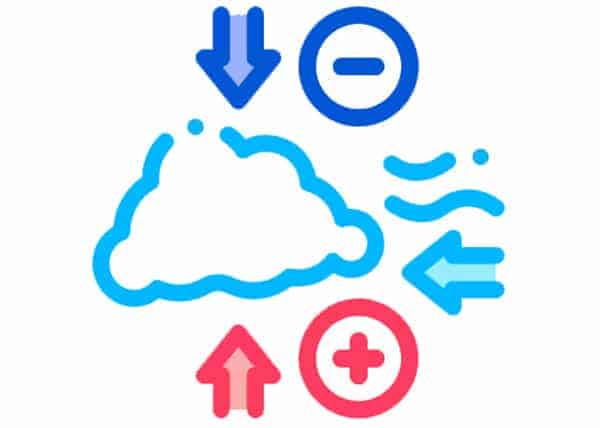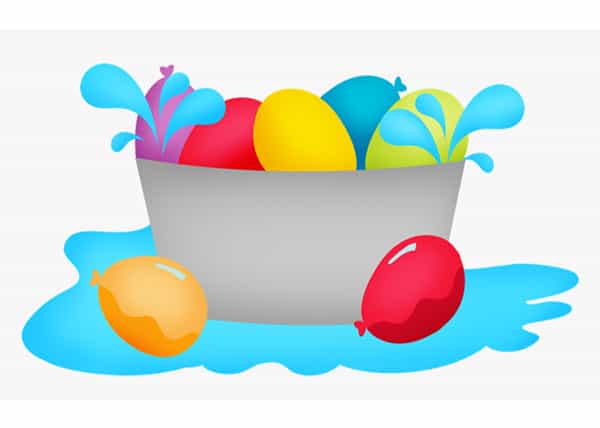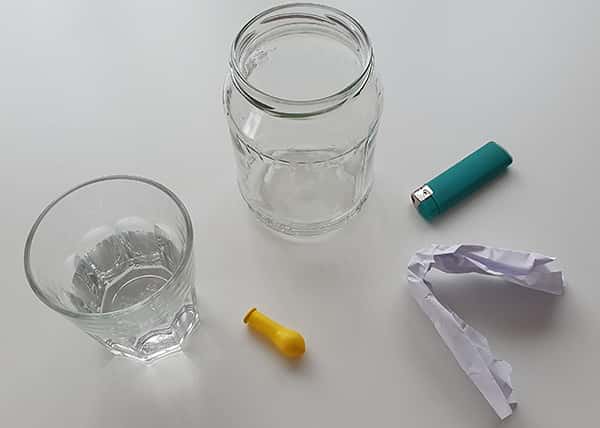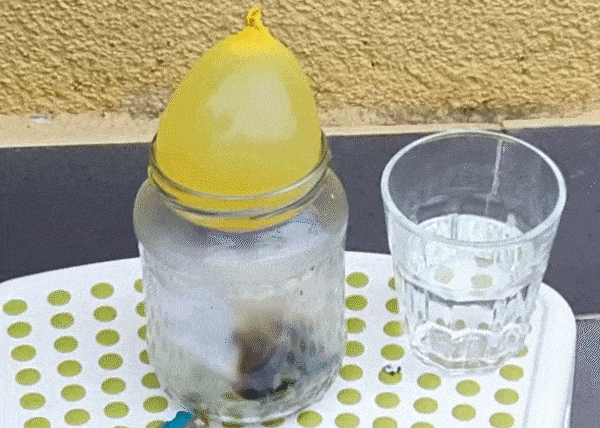How to fit an object through a smaller hole? Not easy, that is for sure. But we can turn towards science and get some help from atmospheric pressure. So let’s do just that – fit the balloon into the glass jar by using the air pressure!
Article Contents
1. What is air pressure or atmospheric pressure?2. What are balloons made of?
3. Required materials for balloon air pressure experiment
4. Instructions to make balloon air pressure experiment
5. The science behind the air pressure experiment with a balloon
6. What will you learn and what skills will you develop?
What is air pressure or atmospheric pressure?
The pressure that is all around us is called air pressure or atmospheric pressure. We define it as the force exerted on a surface by the air above the object, as the gravity pulls that air towards the ground. Another popular definition: Atmospheric pressure is the force per unit area exerted by the mass of the atmosphere as gravity pulls it to Earth.

We measure atmospheric pressure or barometric pressure with a device called a barometer. The unit we use to measure atmospheric pressure is atm. Atm stands for the standard atmosphere and it’s a unit of pressure defined as 101,325 Pa (pascal). Atm is equal to Earth’s average air pressure at sea level.
We already talked a lot about air pressure in How to Demonstrate Air Pressure with Can Crush Experiment. We suggest you check it out for more information.
What are balloons made of?
Balloon production came a long way from when it was first invented. The first balloons were made from animal intestines and bladders. Nowadays, balloons are made mostly from latex, rubber, and nylon fabric.

These materials are long particles called polymers. Polymers are elastic, which means they will scratch when you pull them and shrink when you let them go. As mentioned, latex, rubber, and nylon fabric are all made of polymers and that is why they are the most popular materials to produce balloons nowadays.
We already talked a lot about balloons in the 5 amazing Balloon experiments article, so check it out to learn more. Also, we recommend you check this great video that shows the industrial process of balloon making.
Required materials for balloon air pressure experiment

- Balloon. Any balloon will do but we recommend using a water balloon. Water balloons are small enough to best fit the jar opening and are designed to be filled with water. Also, they come in packs so you will have some spare balloons if the balloon breaks before the experiment is done.
- Glass Jar. Any glass jar will serve as long as the balloon can fit through the opening. A pickle jar, olives jar, or jam jar will be great for the experiment.
- Lighter or matches. We will need a lighter or matches to set the paper at flame before putting it into the jar. Have some spare matches or enough gas in the lighter if you need to light the fire again since the fire can die out in the jar.
- Piece of paper. Any paper will be great as long as it wants to burn. Not much paper is needed, just enough to fill the bottom of the jar. So the bigger the jar, the bigger piece of paper you will need.
- A glass of water. Since we are dealing with fire, it is always good to have some water by hand. That is why we recommend you have some water in a glass or bottle next to you when conducting this experiment.
Instructions to make balloon air pressure experiment
If you would rather like to watch the “how-to” video for this experiment, we have added the video at the beginning of the article. And for a step-by-step guide, continue reading the instructions below.
Warning: Since this experiment requires some fire, it is strongly recommended to conduct the activity outside, in a safe environment. Also, this activity should be conducted under the supervision of adults for all under-aged children.
- Take the balloon and fill it with water. We need water inside of the balloon so it can withstand the heat from the fire and not explode which can happen with only air inside. A water balloon is the best for this activity since it is made for holding water. Attach the balloon to the water pipe and fill the balloon.
- After the balloon is filled, remove it from the pipe, but don’t tie it up just yet. Take the glass jar and see how the balloon fits the opening. Make sure the balloon can’t fall inside of the jar, but also make sure it is not that much bigger than the opening. You can spill some water out of the balloon if it is too big to make it fit the jar opening better.
- Tie the balloon. This can be tricky but there are many ways we can do this. If you can’t use the balloon end to tie it up around itself, you can use some wool or thin rope to tie the balloon. After tying the balloon, we are ready for the experiment.
- We strongly suggest you go outside for the next steps. There could be smoke and you probably don’t want the smoke indoors.
- Take a piece of paper and light it with matches or a lighter. Make sure the paper is burning and if the fire goes off, light it again. The fire must be burning to create pressure.
- Put the burning paper inside of the glass jar. If the paper is still burning inside, proceed to the next step. If the fire went off, light the paper again.
- Put the balloon on top of the jar opening. Observe what is happening. You will see the balloon being sucked inside of the jar due to created pressure.
- After the balloon is sucked in, we recommend you take a prepared glass or bottle of water and pour some water inside of the jar. This is a safety precaution to make sure there is no more fire.
- And you are done! Now it’s time for discussion about what happened in the experiment.
The science behind the air pressure experiment with a balloon
When we place the inflated balloon or balloon filled with water atop the jar, the balloon won’t fall through the opening. Since the air inside of the jar is preventing it from falling down, and the balloon covers the whole opening, it will just sit atop the jar. At this time, the air pressure is the same inside, and outside of the jar.
To get the balloon sucked into the jar, we need to create the difference in air pressure. When we start the fire inside the jar, the temperature rises and the air inside gets warm. Warm air spreads more and is less dense, which means the pressure decreases since the air gets warmer.
When we put the balloon on top of the jar, we prevent new air from coming inside of the jar.
The balloon acts as a one-way barrier, preventing new air to come in but letting the hot air go out. As the air inside of the jar gets warmer, it will escape the jar, but new air won’t come in. If you see a balloon shake, that means the hot air is coming out and shaking the balloon.
And as more air goes out of the jar, the difference in air pressure becomes higher – low pressure inside of the jar and higher pressure outside of the jar.

And since the pressures want to achieve equilibrium again, the balloon is sucked in until the air outside can again find some way to enter the jar – by pushing the balloon inside of the jar and opening the hole for the free flow of air again.
What will you learn and what skills will you develop?
- Learning about air pressure. You will learn about what is air pressure, differences in air pressure, and how to demonstrate different air pressures. Also, you will see what happens when air pressure is out of balance.
- Learn about balloons. You will learn about balloon properties and the materials they are made of which is all part of the chemistry knowledge.
- Conducting scientific experiments. Demonstrating air pressure with a balloon is a scientific method and you will learn how to plan, prepare, conduct experiments, and in the end analyze and draw conclusions.
- Develop judgment and critical thinking. By talking about procedure and results, we develop our analytical thinking and judgment. We can also discuss what can be done differently and further develop our divergent thinking.
- Build awareness about needed safety precautions. You will build awareness and learn about safety measurements that we should always take when doing experiments. In our case, to go outside and have water close by since we were making fire.
We hope you enjoyed this experiment and learned something new about atmospheric pressure. If you’re interested in more similar activities and fun experiments, we have some recommendations:
- As already mentioned, if you want to demonstrate air pressure with one more activity, you can try the Can Crush Experiment.
- Another great way to see how air pressure works is by getting the water raise. You can see how to do that in the Candle in the vacuum experiment.
- And if you just want more balloon activities, we have plenty more in 5 amazing Balloon experiments article.
- We also recommend another interesting and simple experiment to demonstrate buoyancy with the Orange density experiment.
We wish you happy and successful experimentation! But no pressure 😉
If you’re searching for some great STEM Activities for Kids and Child development tips, you’re in the right place! Check the Categories below to find the right activity for you.

STEM Science
Videos, guides and explanations about STEM Science in a step-by-step way with materials you probably already have at your home. Find new Science ideas.
Read more
STEM Technology
Videos, guides and explanations about STEM Technology in a step-by-step way with materials you probably already have at your home. Find new Technology ideas.
Read more
STEM Engineering
Videos, guides and explanations about STEM Engineering in a step-by-step way with materials you probably already have at your home. New Engineering ideas!
Read more
STEM Math
Videos, guides and explanations about STEM Math in a step-by-step way with materials you probably already have at your home. Find new Mathematics ideas.
Read more
Psychology
Find out all about development psychology topics that you always wanted to know. Here are articles from child psychology and development psychology overall.
Read more
First year of Child’s Life
Following a Child’s development every month from its birth. Personal experiences and tips on how to cope with challenges that you will face in parenting.
Read more
2 thoughts on “How to Demonstrate Air Pressure with Balloon”